Abstract
Trichothiodystrophy (TTD) is a rare, autosomal recessive disorder characterized by sulfur-deficient brittle hair and nails, mental retardation, impaired sexual development, and ichthyosis. Photosensitivity has been reported in approximately 50% of the cases, but no skin cancer is associated with TTD. Virtually all photosensitive TTD patients have a deficiency in the nucleotide excision repair (NER) of UV-induced DNA damage that is indistinguishable from that of xeroderma pigmentosum (XP) complementation group D (XP-D) patients. DNA repair defects in XP-D are associated with two additional, quite different diseases; XP, a sun-sensitive and cancer-prone repair disorder, and Cockayne syndrome (CS), a photosensitive condition characterized by physical and mental retardation and wizened facial appearance. One photosensitive TTD case constitutes a new repair-deficient complementation group, TTD-A. Remarkably, both TTD-A and XP-D defects are associated with subunits of TFIIH, a basal transcription factor with a second function in DNA repair. Thus, mutations in TFIIH components may, on top of a repair defect, also cause transcriptional insufficiency, which may explain part of the non-XP clinical features of TTD. Besides XPD and TTDA, the XPB gene product is also part of TFIIH. To date, three patients with the remarkable conjunction of XP and CS but not TTD have been assigned to XP complementation group B (XP-B). Here we present the characterization of the NER defect in two mild TTD patients (TTD6VI and TTD4VI) and confirm the assignment to X-PB. The causative mutation was found to be a single base substitution resulting in a missense mutation (T119P) in a region of the XPB protein completely conserved in yeast, Drosophila, mouse, and man. These findings define a third TTD complementation group, extend the clinical heterogeneity associated with XP-B, stress the exclusive relationship between TTD and mutations in subunits of repair/transcription factor TFIIH, and strongly support the concept of "transcription syndromes."
Full text
PDF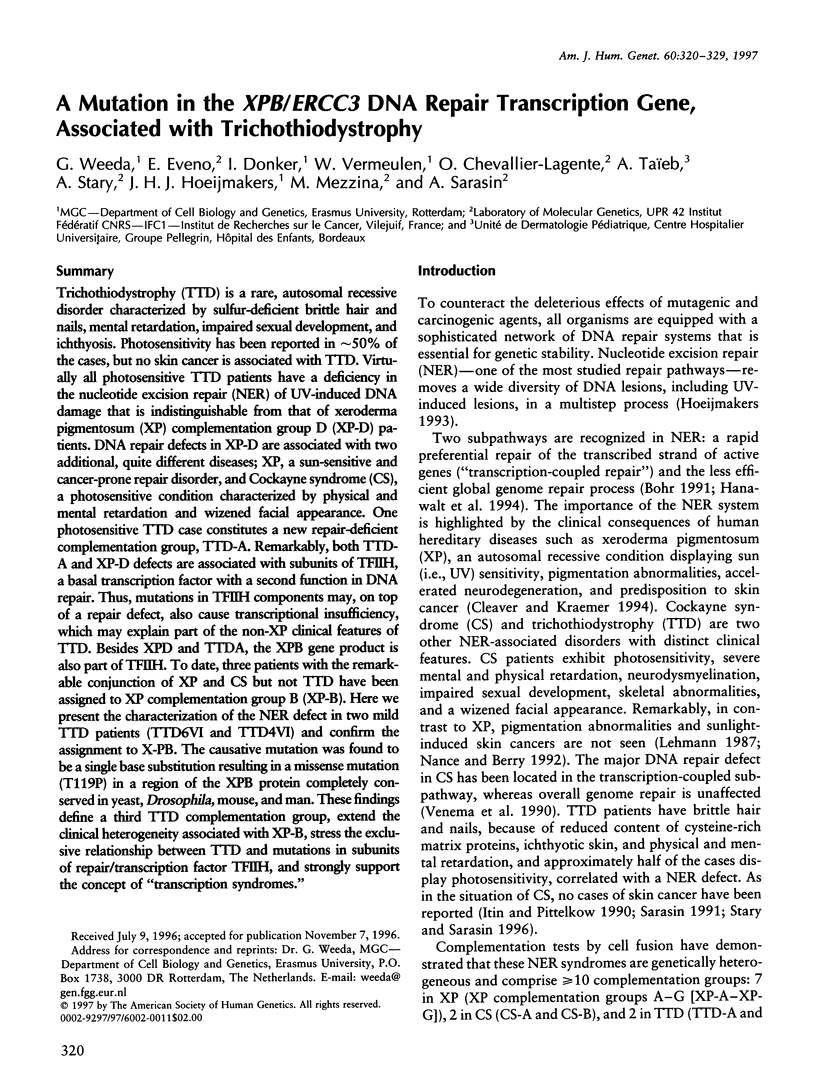


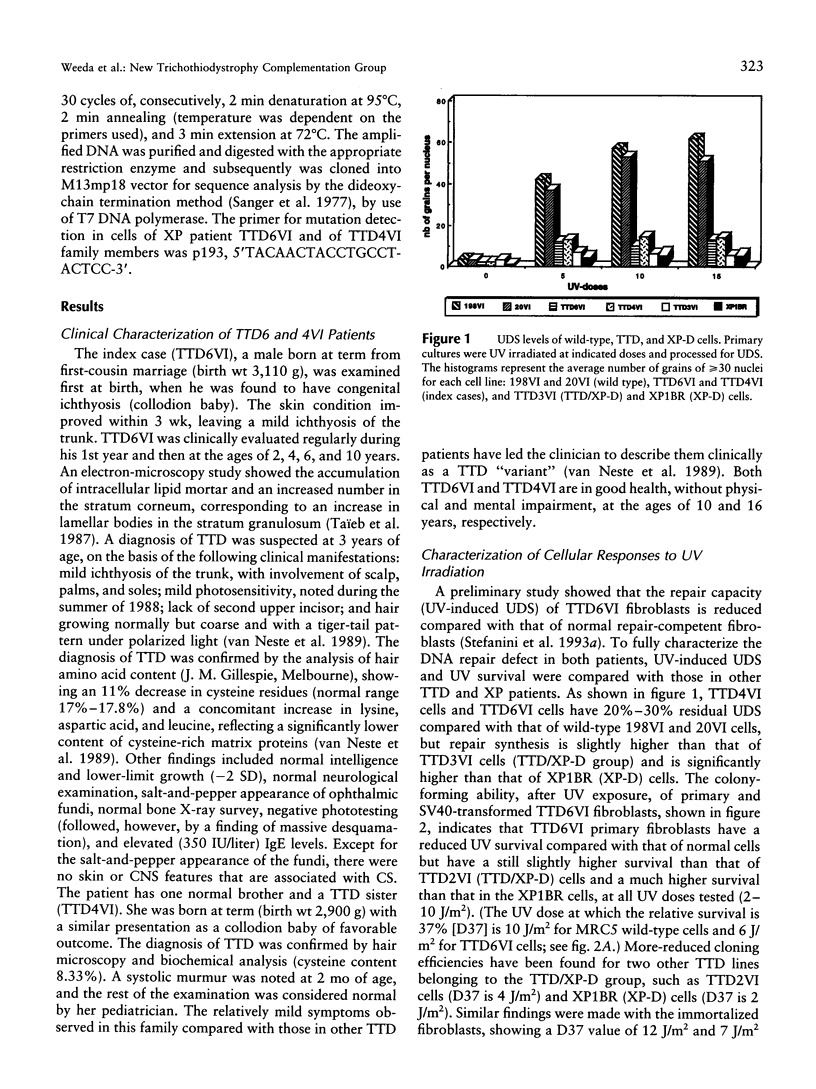


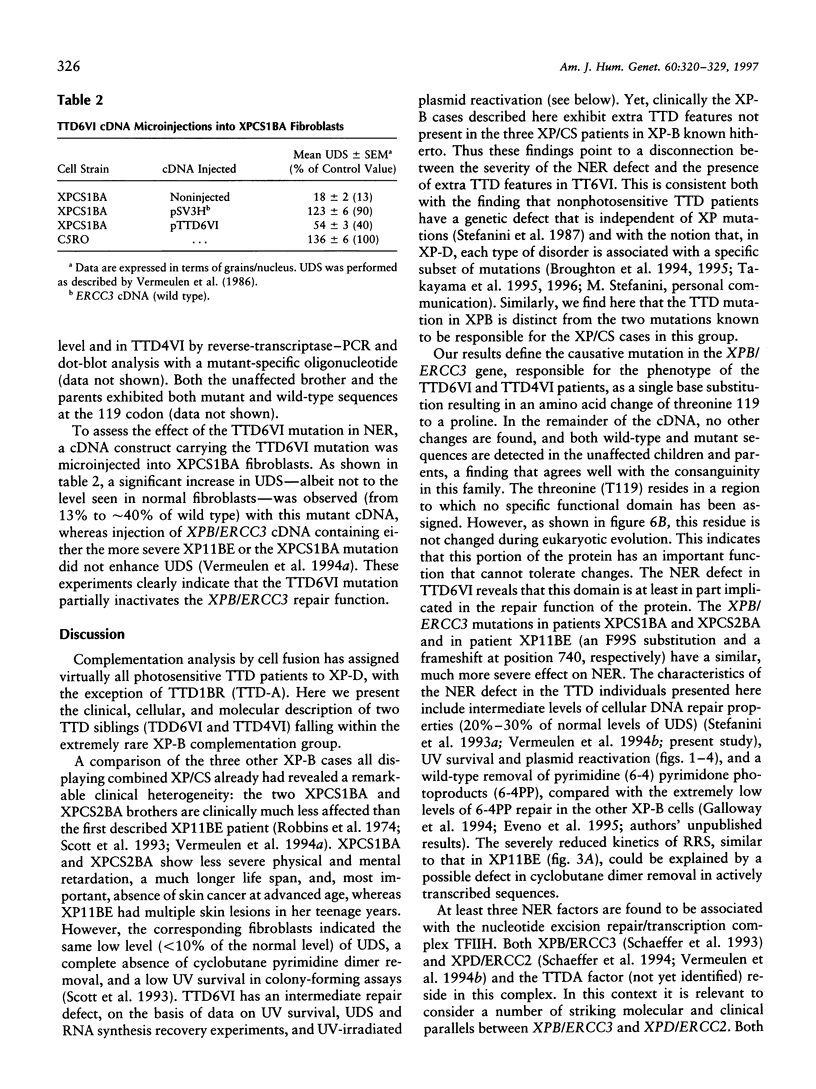

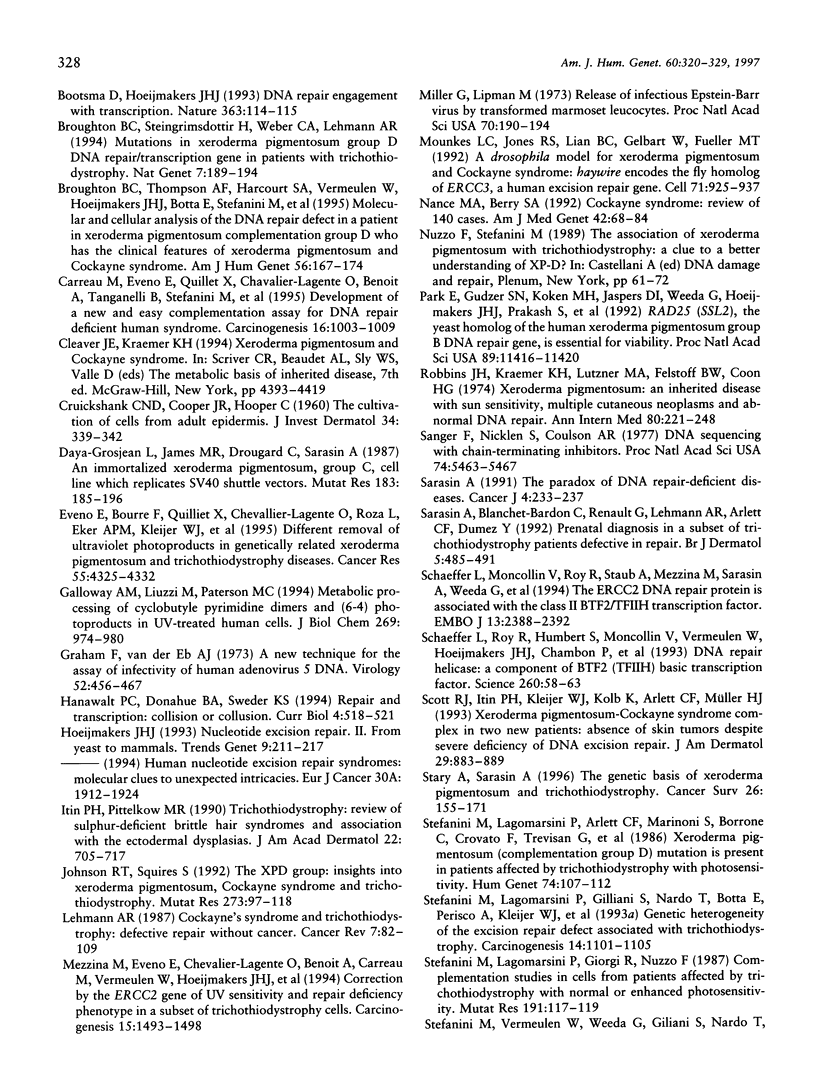
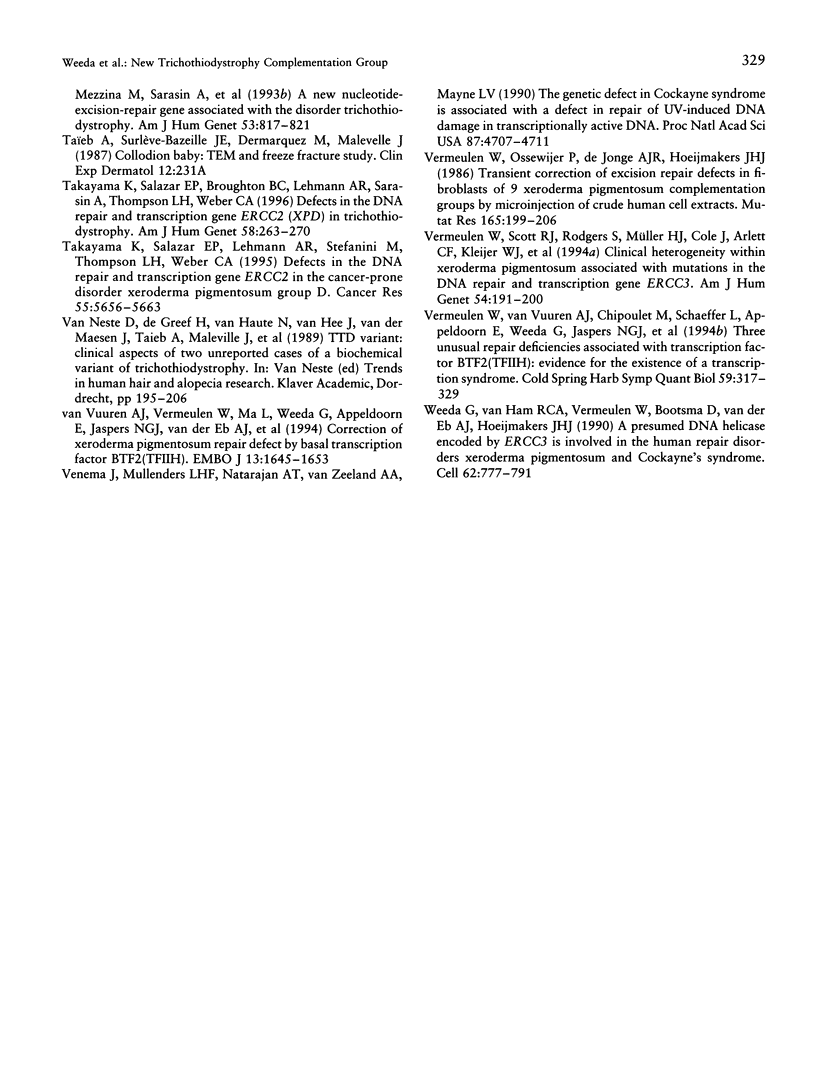
Images in this article
Selected References
These references are in PubMed. This may not be the complete list of references from this article.
- Auffray C., Rougeon F. Purification of mouse immunoglobulin heavy-chain messenger RNAs from total myeloma tumor RNA. Eur J Biochem. 1980 Jun;107(2):303–314. doi: 10.1111/j.1432-1033.1980.tb06030.x. [DOI] [PubMed] [Google Scholar]
- Bohr V. A. Gene specific DNA repair. Carcinogenesis. 1991 Nov;12(11):1983–1992. doi: 10.1093/carcin/12.11.1983. [DOI] [PubMed] [Google Scholar]
- Bootsma D., Hoeijmakers J. H. DNA repair. Engagement with transcription. Nature. 1993 May 13;363(6425):114–115. doi: 10.1038/363114a0. [DOI] [PubMed] [Google Scholar]
- Broughton B. C., Steingrimsdottir H., Weber C. A., Lehmann A. R. Mutations in the xeroderma pigmentosum group D DNA repair/transcription gene in patients with trichothiodystrophy. Nat Genet. 1994 Jun;7(2):189–194. doi: 10.1038/ng0694-189. [DOI] [PubMed] [Google Scholar]
- Broughton B. C., Thompson A. F., Harcourt S. A., Vermeulen W., Hoeijmakers J. H., Botta E., Stefanini M., King M. D., Weber C. A., Cole J. Molecular and cellular analysis of the DNA repair defect in a patient in xeroderma pigmentosum complementation group D who has the clinical features of xeroderma pigmentosum and Cockayne syndrome. Am J Hum Genet. 1995 Jan;56(1):167–174. [PMC free article] [PubMed] [Google Scholar]
- CRUICKSHANK C. N., COOPER J. R., HOOPER C. The cultivation of cells from adult epidermis. J Invest Dermatol. 1960 May;34:339–342. [PubMed] [Google Scholar]
- Carreau M., Eveno E., Quilliet X., Chevalier-Lagente O., Benoit A., Tanganelli B., Stefanini M., Vermeulen W., Hoeijmakers J. H., Sarasin A. Development of a new easy complementation assay for DNA repair deficient human syndromes using cloned repair genes. Carcinogenesis. 1995 May;16(5):1003–1009. doi: 10.1093/carcin/16.5.1003. [DOI] [PubMed] [Google Scholar]
- Daya-Grosjean L., James M. R., Drougard C., Sarasin A. An immortalized xeroderma pigmentosum, group C, cell line which replicates SV40 shuttle vectors. Mutat Res. 1987 Mar;183(2):185–196. doi: 10.1016/0167-8817(87)90061-7. [DOI] [PubMed] [Google Scholar]
- Eveno E., Bourre F., Quilliet X., Chevallier-Lagente O., Roza L., Eker A. P., Kleijer W. J., Nikaido O., Stefanini M., Hoeijmakers J. H. Different removal of ultraviolet photoproducts in genetically related xeroderma pigmentosum and trichothiodystrophy diseases. Cancer Res. 1995 Oct 1;55(19):4325–4332. [PubMed] [Google Scholar]
- Galloway A. M., Liuzzi M., Paterson M. C. Metabolic processing of cyclobutyl pyrimidine dimers and (6-4) photoproducts in UV-treated human cells. Evidence for distinct excision-repair pathways. J Biol Chem. 1994 Jan 14;269(2):974–980. [PubMed] [Google Scholar]
- Graham F. L., van der Eb A. J. A new technique for the assay of infectivity of human adenovirus 5 DNA. Virology. 1973 Apr;52(2):456–467. doi: 10.1016/0042-6822(73)90341-3. [DOI] [PubMed] [Google Scholar]
- Hanawalt P. C., Donahue B. A., Sweder K. S. Repair and transcription. Collision or collusion? Curr Biol. 1994 Jun 1;4(6):518–521. doi: 10.1016/s0960-9822(00)00112-3. [DOI] [PubMed] [Google Scholar]
- Hoeijmakers J. H. Nucleotide excision repair. II: From yeast to mammals. Trends Genet. 1993 Jun;9(6):211–217. doi: 10.1016/0168-9525(93)90121-w. [DOI] [PubMed] [Google Scholar]
- Itin P. H., Pittelkow M. R. Trichothiodystrophy: review of sulfur-deficient brittle hair syndromes and association with the ectodermal dysplasias. J Am Acad Dermatol. 1990 May;22(5 Pt 1):705–717. doi: 10.1016/0190-9622(90)70096-z. [DOI] [PubMed] [Google Scholar]
- Johnson R. T., Squires S. The XPD complementation group. Insights into xeroderma pigmentosum, Cockayne's syndrome and trichothiodystrophy. Mutat Res. 1992 Mar;273(2):97–118. doi: 10.1016/0921-8777(92)90072-b. [DOI] [PubMed] [Google Scholar]
- Mezzina M., Eveno E., Chevallier-Lagente O., Benoit A., Carreau M., Vermeulen W., Hoeijmakers J. H., Stefanini M., Lehmann A. R., Weber C. A. Correction by the ERCC2 gene of UV sensitivity and repair deficiency phenotype in a subset of trichothiodystrophy cells. Carcinogenesis. 1994 Aug;15(8):1493–1498. doi: 10.1093/carcin/15.8.1493. [DOI] [PubMed] [Google Scholar]
- Miller G., Lipman M. Release of infectious Epstein-Barr virus by transformed marmoset leukocytes. Proc Natl Acad Sci U S A. 1973 Jan;70(1):190–194. doi: 10.1073/pnas.70.1.190. [DOI] [PMC free article] [PubMed] [Google Scholar]
- Mounkes L. C., Jones R. S., Liang B. C., Gelbart W., Fuller M. T. A Drosophila model for xeroderma pigmentosum and Cockayne's syndrome: haywire encodes the fly homolog of ERCC3, a human excision repair gene. Cell. 1992 Dec 11;71(6):925–937. doi: 10.1016/0092-8674(92)90389-t. [DOI] [PubMed] [Google Scholar]
- Nance M. A., Berry S. A. Cockayne syndrome: review of 140 cases. Am J Med Genet. 1992 Jan 1;42(1):68–84. doi: 10.1002/ajmg.1320420115. [DOI] [PubMed] [Google Scholar]
- Park E., Guzder S. N., Koken M. H., Jaspers-Dekker I., Weeda G., Hoeijmakers J. H., Prakash S., Prakash L. RAD25 (SSL2), the yeast homolog of the human xeroderma pigmentosum group B DNA repair gene, is essential for viability. Proc Natl Acad Sci U S A. 1992 Dec 1;89(23):11416–11420. doi: 10.1073/pnas.89.23.11416. [DOI] [PMC free article] [PubMed] [Google Scholar]
- Robbins J. H., Kraemer K. H., Lutzner M. A., Festoff B. W., Coon H. G. Xeroderma pigmentosum. An inherited diseases with sun sensitivity, multiple cutaneous neoplasms, and abnormal DNA repair. Ann Intern Med. 1974 Feb;80(2):221–248. doi: 10.7326/0003-4819-80-2-221. [DOI] [PubMed] [Google Scholar]
- Sanger F., Nicklen S., Coulson A. R. DNA sequencing with chain-terminating inhibitors. Proc Natl Acad Sci U S A. 1977 Dec;74(12):5463–5467. doi: 10.1073/pnas.74.12.5463. [DOI] [PMC free article] [PubMed] [Google Scholar]
- Sarasin A., Blanchet-Bardon C., Renault G., Lehmann A., Arlett C., Dumez Y. Prenatal diagnosis in a subset of trichothiodystrophy patients defective in DNA repair. Br J Dermatol. 1992 Nov;127(5):485–491. doi: 10.1111/j.1365-2133.1992.tb14845.x. [DOI] [PubMed] [Google Scholar]
- Schaeffer L., Moncollin V., Roy R., Staub A., Mezzina M., Sarasin A., Weeda G., Hoeijmakers J. H., Egly J. M. The ERCC2/DNA repair protein is associated with the class II BTF2/TFIIH transcription factor. EMBO J. 1994 May 15;13(10):2388–2392. doi: 10.1002/j.1460-2075.1994.tb06522.x. [DOI] [PMC free article] [PubMed] [Google Scholar]
- Schaeffer L., Roy R., Humbert S., Moncollin V., Vermeulen W., Hoeijmakers J. H., Chambon P., Egly J. M. DNA repair helicase: a component of BTF2 (TFIIH) basic transcription factor. Science. 1993 Apr 2;260(5104):58–63. doi: 10.1126/science.8465201. [DOI] [PubMed] [Google Scholar]
- Scott R. J., Itin P., Kleijer W. J., Kolb K., Arlett C., Muller H. Xeroderma pigmentosum-Cockayne syndrome complex in two patients: absence of skin tumors despite severe deficiency of DNA excision repair. J Am Acad Dermatol. 1993 Nov;29(5 Pt 2):883–889. doi: 10.1016/0190-9622(93)70263-s. [DOI] [PubMed] [Google Scholar]
- Stary A., Sarasin A. The genetic basis of xeroderma pigmentosum and trichothiodystrophy syndromes. Cancer Surv. 1996;26:155–171. [PubMed] [Google Scholar]
- Stefanini M., Lagomarsini P., Arlett C. F., Marinoni S., Borrone C., Crovato F., Trevisan G., Cordone G., Nuzzo F. Xeroderma pigmentosum (complementation group D) mutation is present in patients affected by trichothiodystrophy with photosensitivity. Hum Genet. 1986 Oct;74(2):107–112. doi: 10.1007/BF00282072. [DOI] [PubMed] [Google Scholar]
- Stefanini M., Lagomarsini P., Giliani S., Nardo T., Botta E., Peserico A., Kleijer W. J., Lehmann A. R., Sarasin A. Genetic heterogeneity of the excision repair defect associated with trichothiodystrophy. Carcinogenesis. 1993 Jun;14(6):1101–1105. doi: 10.1093/carcin/14.6.1101. [DOI] [PubMed] [Google Scholar]
- Stefanini M., Lagomarsini P., Giorgi R., Nuzzo F. Complementation studies in cells from patients affected by trichothiodystrophy with normal or enhanced UV photosensitivity. Mutat Res. 1987 Jun;191(2):117–119. doi: 10.1016/0165-7992(87)90139-4. [DOI] [PubMed] [Google Scholar]
- Stefanini M., Vermeulen W., Weeda G., Giliani S., Nardo T., Mezzina M., Sarasin A., Harper J. I., Arlett C. F., Hoeijmakers J. H. A new nucleotide-excision-repair gene associated with the disorder trichothiodystrophy. Am J Hum Genet. 1993 Oct;53(4):817–821. [PMC free article] [PubMed] [Google Scholar]
- Takayama K., Salazar E. P., Broughton B. C., Lehmann A. R., Sarasin A., Thompson L. H., Weber C. A. Defects in the DNA repair and transcription gene ERCC2(XPD) in trichothiodystrophy. Am J Hum Genet. 1996 Feb;58(2):263–270. [PMC free article] [PubMed] [Google Scholar]
- Takayama K., Salazar E. P., Lehmann A., Stefanini M., Thompson L. H., Weber C. A. Defects in the DNA repair and transcription gene ERCC2 in the cancer-prone disorder xeroderma pigmentosum group D. Cancer Res. 1995 Dec 1;55(23):5656–5663. [PubMed] [Google Scholar]
- Venema J., Mullenders L. H., Natarajan A. T., van Zeeland A. A., Mayne L. V. The genetic defect in Cockayne syndrome is associated with a defect in repair of UV-induced DNA damage in transcriptionally active DNA. Proc Natl Acad Sci U S A. 1990 Jun;87(12):4707–4711. doi: 10.1073/pnas.87.12.4707. [DOI] [PMC free article] [PubMed] [Google Scholar]
- Vermeulen W., Osseweijer P., de Jonge A. J., Hoeijmakers J. H. Transient correction of excision repair defects in fibroblasts of 9 xeroderma pigmentosum complementation groups by microinjection of crude human cell extracts. Mutat Res. 1986 May;165(3):199–206. doi: 10.1016/0167-8817(86)90055-6. [DOI] [PubMed] [Google Scholar]
- Vermeulen W., Scott R. J., Rodgers S., Müller H. J., Cole J., Arlett C. F., Kleijer W. J., Bootsma D., Hoeijmakers J. H., Weeda G. Clinical heterogeneity within xeroderma pigmentosum associated with mutations in the DNA repair and transcription gene ERCC3. Am J Hum Genet. 1994 Feb;54(2):191–200. [PMC free article] [PubMed] [Google Scholar]
- Vermeulen W., van Vuuren A. J., Chipoulet M., Schaeffer L., Appeldoorn E., Weeda G., Jaspers N. G., Priestley A., Arlett C. F., Lehmann A. R. Three unusual repair deficiencies associated with transcription factor BTF2(TFIIH): evidence for the existence of a transcription syndrome. Cold Spring Harb Symp Quant Biol. 1994;59:317–329. doi: 10.1101/sqb.1994.059.01.036. [DOI] [PubMed] [Google Scholar]
- Weeda G., van Ham R. C., Vermeulen W., Bootsma D., van der Eb A. J., Hoeijmakers J. H. A presumed DNA helicase encoded by ERCC-3 is involved in the human repair disorders xeroderma pigmentosum and Cockayne's syndrome. Cell. 1990 Aug 24;62(4):777–791. doi: 10.1016/0092-8674(90)90122-u. [DOI] [PubMed] [Google Scholar]
- van Vuuren A. J., Vermeulen W., Ma L., Weeda G., Appeldoorn E., Jaspers N. G., van der Eb A. J., Bootsma D., Hoeijmakers J. H., Humbert S. Correction of xeroderma pigmentosum repair defect by basal transcription factor BTF2 (TFIIH). EMBO J. 1994 Apr 1;13(7):1645–1653. doi: 10.1002/j.1460-2075.1994.tb06428.x. [DOI] [PMC free article] [PubMed] [Google Scholar]



